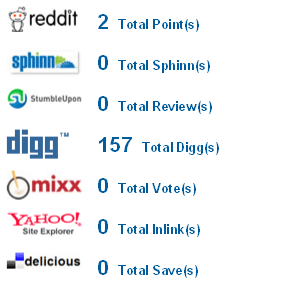Track Social Media Analytics
Social media is a relatively new phenomenon, but Delicious, Digg, StumbleUpon and other social media websites have become an increasingly important source of website traffic. This also creates a massive demand for data related to social media. Where are users coming from? What topics excite them?
These are questions that, when answered, can be the difference between a successful website and a failed social media campaign. But social media analytics is young, and not many people know where to start. This guide is designed for that purpose: to help you get started with some of the best tools and habits so that you can effectively gather and analyze social media analytics.
Understand what you want to track
As with most things in life, you can’t conquer what you don’t understand, or at least what you haven’t really thought about.
What is your goal? Do you want to track how people are sharing your website? Do you want to track a specific social media campaign? Or maybe you’re just interested in trends related to a specific meme or social media phenomenon? Each one requires different tools and different focus.
You’re going to focus on traffic statistics if you’re tracking social media website engagement, while if you’re tracking a wider campaign, Twitter response and positive comments might be a more appropriate metric.
Optimize your existing analytics software
Most of us use analytics software like Google Analytics, Woopra, or Omniture to track website data like traffic, visitors, pages per visitor, and traffic sources. Most of these analytics tools can track a wealth of data, but they are not designed to track social media data. Luckily, there are a few ways to beef up your analytics software for social media. Some quick tools and suggestions:
Social Media Metrics Plugin: Social Media Metrics is a greasemonkey extension that adds a social media information layer to Google Analytics, providing information on Diggs, stumbles, delicious bookmarks, and more for each individual page. Be aware – it’s not perfect.
Set up specific campaigns and events for social media: Most analytics software has custom campaigns to make it easy to track specific events. You can track a specific Twitter traffic campaign or DiggBar URL with campaigns.
Reorganize dashboards and set up email reports: To get specific information on social media, have traffic stats from top social media websites (i.e. Digg, Facebook, Twitter, etc.) emailed to you so you can see it all in one place. In addition, reorganize any dashboards you have to show this information for easy access.
Add new analytics tools

 Even with web analytics tools, you don’t have all the tools necessary to get started tracking analytics related to social media. Why not add some more tools to your inventory that track detailed social metrics? Some suggestions:
Even with web analytics tools, you don’t have all the tools necessary to get started tracking analytics related to social media. Why not add some more tools to your inventory that track detailed social metrics? Some suggestions:
Bit.ly: When you use a URL shortener, it’s always a smart idea to use one that has analytics information, like Bit.ly. This will track information like number of clicks, traffic sources, and even at what time clicks occur.
Xinureturns: Despite the funny Scientology-inspired name, xinureturns provides a great dashboard overview of your website’s standing in social media. Run a report and you will receive information on Technorati, Googe Pagerank, Diggs, and even backlinks to your website.
PostRank: Formerly known as AideRSS, PostRank provides detailed information on Tweets, stumbles, diggs, and FriendFeed all in one place. It’s best for blogs and websites with a lot of content.
SocialToo: SocialToo is a comprehensive tool for creating social surveys and tracking social stats. It also will send you a daily email describing follows and unfollows on Twitter.
Aggregate your analytics
There are a lot of tools for gathering social media information, but no one place has everything you need. You don’t have time to look at all of the tools, so aggregate your analytics information.
There is no single tool that will bring this information together, so you’ll have to do it yourself. Export data into excel, pdf, or email and record all of the information to one area, whichever works best for you. Building a spreadsheet may be best for playing with the numbers. Make it easily accessible.
Analyze and engage
The last step is always the most important one – the actual analysis. It takes years of dedication to the art of web analytics to really understand how each variable affects website traffic and user engagement, but by looking at this data in one place and comparing the information, you will hopefully be able to pick up on trends.
This guide is only how to get started with social media analytics. Take the time to find great tools and to understand how each of the social media levers affects traffic and analytics data. But most of all, use the data to engage your audience. You can figure out what they’re looking for using social media analytics, so be sure to act upon the data once you’ve analyzed it.










